Effects of crude acetylene fumes on serum heavy metals, haematological indices and histology of the lung tissues of adult Wistar rats
Omigie M I, Agoreyo F O
Abstract
Background: Crude acetylene fumes generated from Calcium carbide (CaC2) is one of the most widely used source of acetylene gas for occupational gas welding and as an artificial fruit ripener despite numerous health warnings from the government and health groups in Nigeria.
Aim: The study was aimed at evaluating the effects of crude acetylene on heavy metals present in serum, haematological indices and histology of the lung tissues.
Materials and Methods: Twenty (20) adult male wistar rats were used. The rats were divided into two groups; Group 1 (control) and Group 2 (Test group) (n=10). The animals from the Test group (n = 10) were subsequently exposed to crude acetylene fumes released from the dissolution of 20g of calcium carbide in water for 30 minutes daily for a period of 4 weeks. At the end of the 4th week, the rats were anaesthetized and blood samples were collected for serum heavy metals and haematological analysis and tissues were harvested for histological studies.
Results: a significant increase is seen in serum heavy metals (Cr, Fe and Cd) but no significant difference in Pb in the Test group compared with the control group. Also, there was a decrease in percentage granulocytes and histological results show destruction of respiratory epithelium. Also, there were significant damages to the lung tissues which include mild interstitial haemorrhage, bronchiolar ulceration with luminal debris, interstitial oedema, bronchiolar haemorrhage vascular distortion and congestion.
Conclusion: Exposure to crude acetylene fumes increases serum heavy metals and can cause disruption of the respiratory epithelium
Keywords: Acetylene fume, Calcium Carbide, Granulocyte, Heavy metals
Introduction
Calcium carbide (CaC2) is used in the production of flammable acetylene gas for welding and fabrication works. CaC2 releases acetylene when it is in contact with moisture.1 Acetylene is a colorless, highly inflammable, garlic-like smelling gas that forms an explosive mixture with air over a wide concentration range.2 Crude calcium carbide often contains arsenic, phosphorus and sulphur impurities and therefore its reaction with water yields, in addition to acetylene: arsine, phosphine, ammonia, hydrogen sulphide and related compounds.
During welding, the toxic substances emitted include: heavy metals, carbon monoxide, carbon dioxide and nitrogen oxides. Due to the state of inefficient power supply in Nigeria, most welders use acetylene gas generated from the reaction of calcium carbide with water.3 Gradecka4 suggested that arsenic found in CaC2 may be a genotoxic carcinogen and that chronic exposure to inorganic arsenic may lead to many cancer types including lung cancer and edema. Also, automobile welders in developing countries like Nigeria are constrained by paucity of funds to rely solely on acetylene generated in situ from the reaction of calcium carbide and water and this may have deleterious effects on blood constituents.5 Hence, this study was aimed at evaluating the effects of crude acetylene fumes on serum heavy metals, selected haematological parameters and histology of the lung of adult Wistar rats.
Materials and methods
Materials: Carbide lumps, plastic cages, syringe, gloves, 10% formal saline (for lung fixation for histology), cotton wool, chloroform, plain bottles, sample bottles, dissecting scissors, air-tight containers, centrifuge
Experimental design
A total of 20 Wistar rats were used for this study. The rats were obtained and housed at the Animal House, Department of Anatomy, University of Benin, Edo state, Nigeria. The animals were first maintained in the animal room and allowed to acclimatize for one week before exposure and they were divided into two groups; Group A: Control Group and Group B: Experimental Group (n=10). Animals in Group B were subjected to inhalation of crude acetylene for 30 minutes at 24 hours intervals for 4 weeks. For this purpose, crude acetylene was generated in situ by addition of 20 g of calcium carbide to 200mL of water and this was placed in a transparent container bearing an air-tight rubber lid that limited exposure to oxygen. Twenty gram CaC2 liberated 0.3125 moles of acetylene which is about the threshold of the daily loading of crude acetylene inhaled by welders in respect to the surface area of a rat.
After the last exposure, the rats were given anesthesia and blood samples and lung tissues were collected to examine changes in haematological parameters (RBC, WBC, RBC indices, platelets count, lymphocytes count, lymphocytes percentage and granulocytes percentage), heavy metals (Cr, Fe, Pb and Cd) in the blood and histology of the lungs
Assay for haematological and heavy metals in the blood and histological.
Blood samples were collected and centrifuged for the determination of serum heavy metals (Cr, Fe, Pb and Cd). The samples were first digested using hydrogen peroxide before they were examined using AAS (Atomic Absorption Spectrometer). The haematological indices (Red blood cells (RBC), White blood cells (WBC), RBC indices, platelets count, lymphocytes count, lymphocytes percentage and granulocytes percentage were done using an automated analyzer. Lung tissue samples that were harvested were fixed with Phosphate Buffer Solution (PBS) for the assays of histological examination: the tissues were preserved (fixed) and cut into sections thin enough to be translucent. Following fixation, blocks of tissue were cut into thin sections. Sections 3 to 10 microns (3 to 10 thousandths of a millimeter) in thickness were cut on steel knives mounted in an instrument called a microtome, which has a precise mechanical advance. The sections were considerably less than one ten-thousandth of a millimeter (0.1 micron; μm) thick. This was accomplished by embedding the tissue in a plastic such as Epson or araldite (epoxy resins) and cutting on special ultra-microtomes equipped with a fine mechanical or thermal advance. Sections were cut with glass or diamond knives and mounted on copper mesh grids. The lung tissue sections for general tissue structure were stained by Hematoxylin plus Eosin technique. The slides were examined under a light microscope and photomicrographs were taken.
Statistical analysis
Data was analyzed using Graph Pad Prism statistical software version 8.1. Results are presented as Mean +/-SEM. Student t-test was used to compare the dependent and independent variables. P-value less than 0.05 (p<0.05) was considered statistically significant.
Results
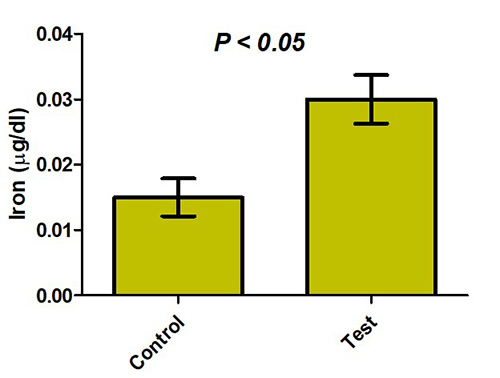
Figure 1: Showing iron concentration of Wistar rats exposed to crude acetylene fumes. There was a significant increase in Test group compared with control (p<0.05)
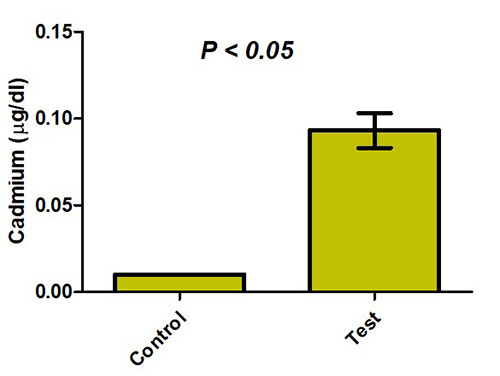
Figure 2: Showing Cadmium concentration of Wistar rats exposed to crude acetylene fumes. There was a significant increase in Test group compared with control (p<0.05)

Figure 3: Showing lead concentration of Wistar rats exposed to crude acetylene fumes. There was no significant difference in Test group compared with control (p>0.05)
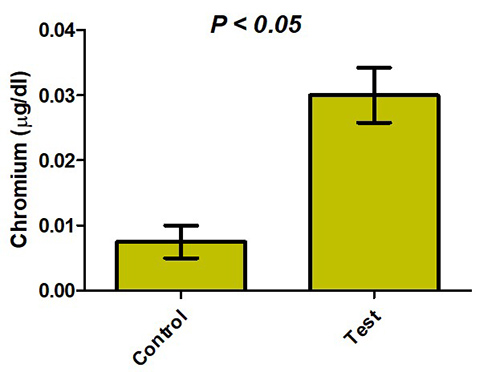
Figure 4: Showing Chromium concentration of Wistar rats exposed to crude acetylene fumes. There was a significant increase in Test group compared with control (p<0.05)
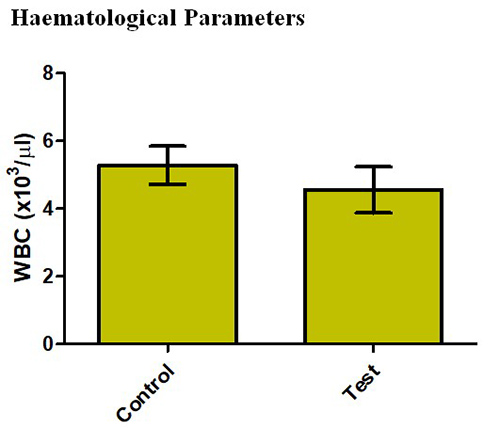
Figure 5: Showing White Blood Cells (x103/µL) of Wistar rats exposed to crude acetylene fumes. There was no significant difference in Test group compared with control (p>0.05)
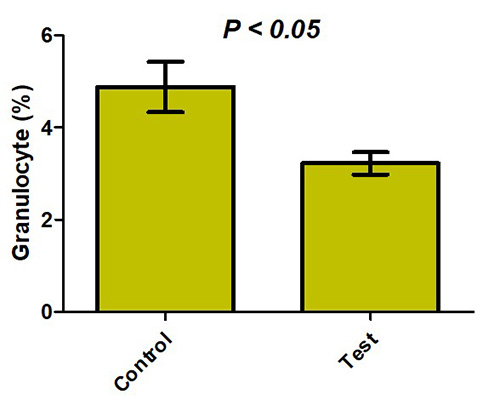
Figure 6: Showing percentage granulocytes (%) of Wistar rats exposed to crude acetylene fumes. There was a significant decrease in animals Test Group compared with control (p<0.05)
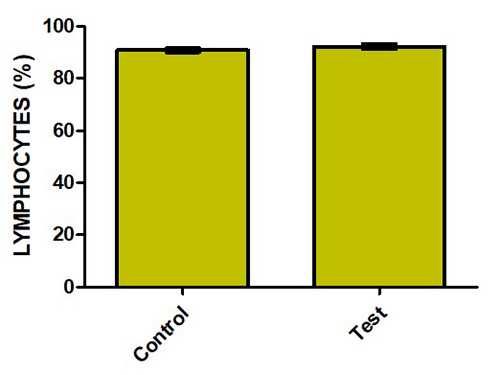
Figure 7: Showed percentage lymphocytes (%) of Wistar rats exposed to crude acetylene fumes. There was no significant difference in Test group compared with control (p>0.05)
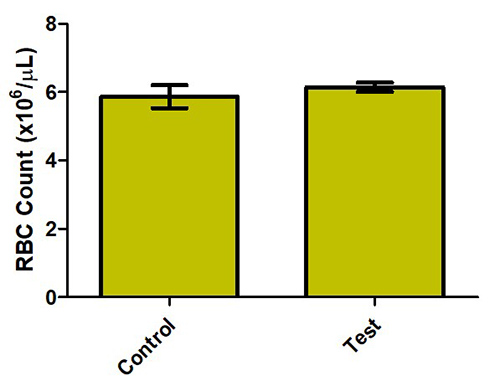
Figure 8: Showing Red Blood Cells (x106/µL) of Wistar rats exposed to crude acetylene fumes. There was no significant difference in Test group compared with control (p>0.05)
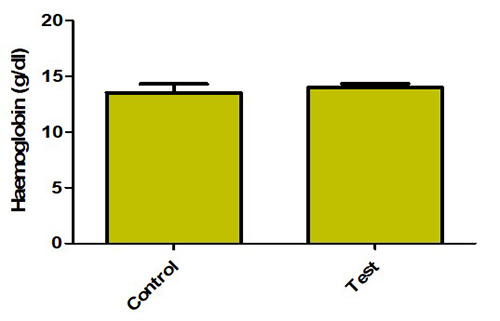
Figure 9: Showing haemoglobin concentration of Wistar rats exposed to crude acetylene fumes. There was no significant difference in Test group compared with control (p>0.05)
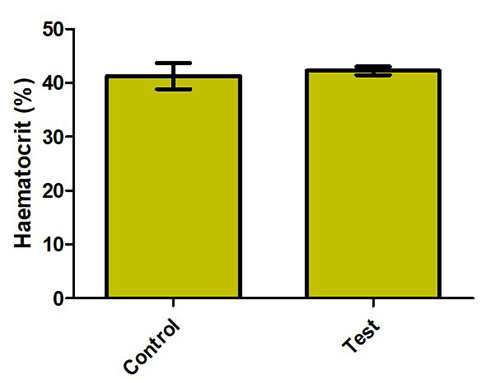
Figure 10: Showing Haematocrit level (%) of Wistar rats exposed to crude acetylene fumes. There was no significant difference in Test group compared with control (p>0.05)
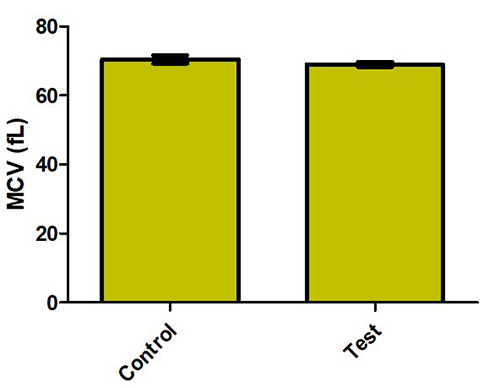
Figure 11: Showing mean corpuscular volume (MCV) of Wistar rats exposed to crude acetylene fumes. There was no significant difference in Test group compared with control (p>0.05)

Figure 12: Showing mean corpuscular haemoglobin (MCH) of Wistar rats exposed to crude acetylene fumes. There was no significant difference in Test group compared with control (p>0.05)

Figure 13: Showing Mean Corpuscular Haemoglobin Concentration (MCHC) of Wistar rats exposed to crude acetylene fumes. There was no significant difference in Test group compared with control (p>0.05)
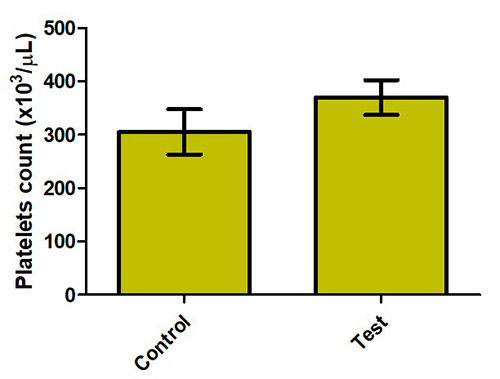
Figure 14: Showing platelets count (x103/µL) of Wistar rats exposed to crude acetylene fumes. There was no significant difference in exposed compared with control (p>0.05)
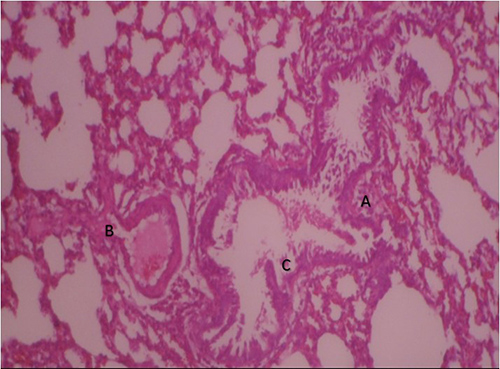
Figure 15: micrograph of the Test group lung showing: (A) mild interstitial haemorrhage, (B) vascular ulceration and congestion, (C) Bronchiolar ulceration with luminal debris. (H&E X100)
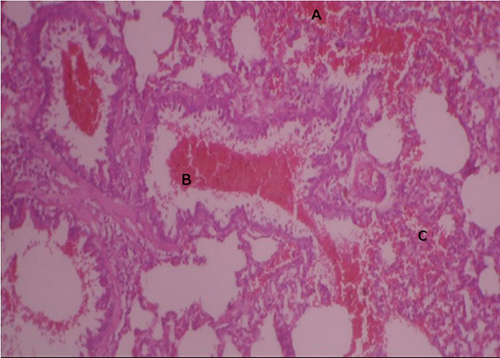
Figure 16: Micrograph of the Experimental lung showing: (A). severe interstitial haemorrhage, B. severe bronchiolar haemorrhage. C. patchy alveolar collapse and haemorrhage (H&E X100)
Discussion
The study involved serial exposure including Sunday when the welders do not usually work. In this study, the use of crude acetylene arose from the need to mimic the operational environment of occupational welders in order to observe the toxic effects regarding serum heavy metals, selected haematological parameters due to their daily activities of being exposed to fumes from dissolved calcium carbide.
Cadmium, iron, chromium and lead are the most common type of metals that existed in welding fumes, of which chromium compounds have been classified as carcinogenic metal.6 The Test group had a statistically higher Cadmium, Iron and Chromium blood concentration compared with the control group. This significant increase in serum cadmium may later on result in a decrease in pack cell volume (PCV). Decrease in PCV is known to compromise vital organ functions through hypoxia.7 Hypoxia in turn impairs membrane integrity and leads to loss of tissue enzymes to the extracellular fluid. Although in this study, there was no significant change in haematocrit value of the test groups compared with the control. This could also be due to the period of exposure to the acetylene fume and the concentration of the acetylene fume inhaled.
There was no significant difference in White blood cells count, percentage lymphocyte and platelet between the test group and the control. Although the white blood cell mean value of the Test group was lower than the control, the decrease was not statistically significant. According to Sani and Abdullahi,8 a significant increase was seen in white blood cell counts in rats exposed to acetylene fumes compared with those unexposed. The difference in this study and theirs could be due to the different methods of exposing the rats to acetylene fumes and the duration of exposure. A significant decrease is seen in percentage granulocytes mean value of the test group compared with the control. No significant change was seen in red blood cells, MCV, MCH and MCHC in the test group compared with control.
From the micrographs, oedema, lung ulceration, bronchiolar constriction, haemorrhage and alveolar collapse were the predominant effects of the fumes on the lungs. Also, mild interstitial haemorrhage and ulceration was found on the lungs. It can be inferred that within days of exposure, destruction of respiratory epithelium occurred.
Conclusion
Exposure to crude acetylene fumes increases serum heavy metals and also results in destruction of the respiratory membrane. This is an indication that inhalation of crude acetylene fumes may be deleterious to human health and thus, protective measures should be employed in occupational activities associated with exposure to crude acetylene fumes.
References
- Asif M. Physico-chemical Properties and Toxic Effect of Fruit Ripening against Calcium Carbide. Ann Trop Med Public Health. 2012; 5:150-160.
- Quincy MA. Fire Protection Guideto Hazardous Materials. National Free Protection Association. 2003; 325
- Hüseyin M, Kurtoglu S, Yagmur F, Gümüs H, Kumandas S, Poyrazoglu MH. Calcium carbide poisoning via food in childhood. J Emerg Med. 2007; 32:179-180.
- Gradecka DOB, Palus JAD, Wasowicz WLK. Selected mechanisms of genotoxic effects of inorganic arsenic compounds. Int J Occupat Med Environ Health. 2001; 14:317-328.
- Andrew GS, Simon UT, John AU, Godwin OO, Alexander NI, Ikagu YM. Studies on changes in some haematological and plasma biochemical parameters in Wistar rats fed on diets containing calcium carbide ripened mango fruits. Int J Food Sci Nutr Eng. 2018; 8: 27-36.
- Rafati RM, Rafati RM, Kazemi S, Moghadamnia AA. Cadmium toxicity and treatment: An update. Caspian J Intern Med. 2017; 8(3):135-145.
- Okolie NP, Ozolua RI, Osagie DE. Some Biochemical and Haematological Effects Associated with Chronic Inhalation of Crude Acetylene in Rabbits. J Med Sci. 2005;5: 21-25.
- Sani A, Abdullahi IL. Effects of welding fumes on haematological parameters of male albino rats (Rattus norvegicus). Biochem Biophys Rep. 2019; 19:100651.